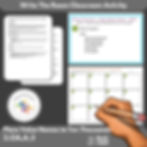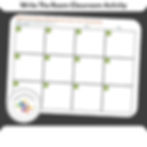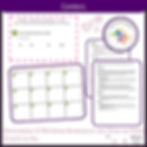Picture a vibrant, energy-infused child, lost in a world of his own. He's perpetually engaged in a thrilling high-speed chase, relentlessly sprinting after an elusive mental butterfly, oblivious to the chalkboard upfront. Welcome to the intriguing, attention-deficit hyperactivity disorder (ADHD) universe in the classroom.

Breaking the Ice: ADHD and the Eternal Daydreamer The students with ADHD are the quintessential daydreamers. Perpetually lost in thought, they often miss the classroom expectations, chasing after their attention, which dances in the rhythm of its own drumbeat.
The Sneaky Symptom: ADHD in Disguise ADHD is like a chameleon. It has a crafty knack for blending in and can manifest as simple lack of interest or an all-encompassing energy burst. But alas! There's more to this beastie than meets the eye!
Impulsive Symptoms: The Unexpected Detour Impulsivity in ADHD is like an impromptu road trip. One moment, students are cruising along the academic highway, and the next, they veer off into the captivating landscapes of their minds. These impulsive detours may manifest as blurting out answers, interrupting others, or an inability to wait their turn. It's the sneaky symptom that often redirects their journey in unpredictable ways.
Hyperactive-Impulsive Symptoms: The Electric Dynamo Hyperactivity coupled with impulsivity in ADHD students is akin to an electric dynamo, constantly generating bursts of energy. They might fidget, squirm, or chatter incessantly, injecting a dose of adrenaline into the academic equation. Their minds race at a mile a minute, with thoughts jumping like hyperactive frogs from one lily pad to the next. It's the charged side of ADHD, the powerhouse that fuels their vibrant and lively nature.
The ABC's of ADHD
ADHD is a neurodevelopmental disorder defined by the Diagnostic and Statistical Manual. It's characterized by continuous inattention, hyperactivity, and impulsivity patterns, which can interfere with other students'' academic experience.
The Alphabet Soup: ADHD vs ADD vs HFA ADHD, ADD, and HFA might sound like random jumbles of the alphabet, but they represent distinct yet interconnected learning disabilities. While ADHD and ADD have overlapping traits, HFA brings its unique set of social communication challenges to the table.
For Dummies: Breaking Down the ADHD Terminology ADHD isn't a mystical code. It simply implies a disorder that affects a child's ability to concentrate and control impulsive behaviors, often resulting in poor organizational skills, which can complicate their educational outcomes.
The Science Behind ADHD
ADHD isn't a whimsical concept; it's a scientific reality. It's associated with dopamine deficits in the brain, which fuel the quest for continuous stimulation, leading to ADHD's hallmark traits of hyperactivity and inattention.
Not Just Naughty: The Brain Chemistry of ADHD Think of an ADHD child as a chemical experiment in progress. Their brain chemistry is different from most kids, resulting in behaviors that may seem disruptive, but are merely expressions of their neurodiversity.
Beyond Behavior: ADHD as a Neurodevelopmental Disorder ADHD is more than just classroom chaos. The unique brain wiring in ADHD often translates into learning challenges, turning even everyday tasks into arduous endeavors.
ADHD Symptoms You Can't Miss
Daydreaming, forgetfulness, impatience, impulsivity - these are the telltale signs of ADHD. While they can create hurdles in classroom learning, they also signify the creative sparks that define these extraordinary kids.
Look Ma, No Focus: Understanding Inattention in ADHD An ADHD child's focus isn't lost; it's just meandering through a more exciting landscape. While they may seem aloof, their mind is often brimming with insights and creativity.
Bouncing Off the Walls: Hyperactivity in the Classroom Hyperactivity in the classroom can be overwhelming. However, if channeled right, this boundless energy can yield unparalleled enthusiasm for learning and creativity.
Too Fast, Too Furious: Impulsivity as a Key ADHD Trait Impulsivity is ADHD's signature style. It's not about reckless abandon but a constant rush of thoughts and actions, a cerebral cyclone that's as challenging as it is exhilarating.
ADHD in Classroom: Teacher's Edition Managing ADHD in the classroom is a task that requires empathy, patience, and innovation. With the right strategies, teachers can turn ADHD students' unique traits into learning advantages.
The Whirling Dervish: Managing Classroom Chaos Classroom accommodations can help manage the energy of ADHD students. Teachers can foster a positive learning environment by adopting techniques that cater to their unique learning
needs.
Homework Wars: The Struggle with Assignments and Tests Homework assignments and tests can often feel like a battleground for students with ADHD. But with the right tools and techniques, they can conquer these academic challenges.
Befriending the Clock: Time Management and ADHD ADHD and time often find themselves in a tumultuous tango. By instilling consistent routines and planning skills, teachers can help students navigate this tricky dance.
Coping Mechanisms for Students with ADHD
From fidget spinners to doodling, unconventional techniques can be a boon for ADHD students. They provide an outlet for their energy and facilitate focus, improving their academic performance.
Taming the Tasmanian Devil: Strategies for Self-Control Self-control isn't about suppressing the storm within but learning to dance in the rain. ADHD students can harness their energy by using positive feedback and adopting strategies that foster self-regulation and positive behavior.
Master of Multitasking: Using Hyperactivity as a Tool Hyperactivity isn't a flaw; it's a potential superpower. With the right support, ADHD students can transform their hyperactive energy into a tool for multitasking and creativity, improving their executive functioning - the process that involves managing oneself and one's resources to achieve a goal.
How Teachers Can Support Students with ADHD
A child's teacher has a pivotal role in supporting ADHD students. By tailoring teaching strategies to their children' unique needs, teachers can foster a conducive learning environment that enhances these students' academic journey.
The ADHD-friendly Classroom: Small Changes, Big Impact Small changes can have a big impact in an ADHD-friendly classroom. By making learning interactive and engaging, teachers can transform the academic experience for students with ADHD.
When Students Met Structure: The Power of Routine and Organization Routine and organization can be a beacon of hope many children see in the ADHD chaos. By fostering structure in the classroom, teachers can provide a sense of stability to students grappling with ADHD.
Taming the Tasmanian Devil: Strategies for Self-Control Self-control isn't about suppressing the storm within but learning to dance in the rain. By adopting strategies that foster self-regulation and positive behavior, such as positive reinforcement, students with ADHD can learn to harness their energy effectively. Positive reinforcement helps students understand and amplify their strengths, turning moments of chaos into opportunities for growth and learning.
Lessons from a Master Teacher: The Importance of Patience and Understanding Patience and understanding aren't just virtues; they are necessities when teaching students with ADHD. They lay the foundation for an inclusive and supportive learning environment, paving the way for academic success.
Role of Parents in Handling ADHD
Parents aren't just spectators in the journey of ADHD; they're active participants. Their love, support, and understanding can provide the emotional scaffolding that their child needs to thrive in spite of ADHD.
Mom, Dad, and ADHD: Parenting a Child with ADHD Parenting a child with ADHD can feel like steering a ship through a storm. But with patience, understanding, and love, parents can navigate this journey, ensuring their child's success both in and out of school.
In Sync with School: Collaborating for Your Child’s Success Collaboration between parents and the school is essential for an ADHD child's success. Together, they can create an academic experience that fosters learning and growth, nurturing the child's self-esteem, potential, and executive function abilities. With support and understanding, students with ADHD can improve their ability to plan, manage time, and organize tasks.
Teachers Can Help At the front line of education, teachers are crucial in providing an environment conducive to learning for a child with ADHD. By understanding the child's unique needs and adopting effective teaching strategies, teachers can greatly enhance the academic experience for these students.
Individualized Education Program (IEP) IEPs can be a boon for students with ADHD. These personalized programs, tailored to the individual needs and abilities of the student, can ensure a child's academic journey is not hampered by ADHD, but is rather a rich learning experience that nurtures their potential.
Trained Staff The importance of trained staff in schools cannot be overstated when it comes to handling ADHD. From the school counselor to the special education teacher, staff who understand ADHD can provide the needed support, helping the child navigate their educational journey.
Special Services Special services in schools, such as additional tutoring or counseling, can be of immense help to children with ADHD. These services provide an extra layer of support, aiding in overcoming learning challenges and ensuring every ADHD child has the best opportunity to succeed.
Embracing the Extraordinary: Changing Our Perception of ADHD ADHD is not a hurdle to overcome; it's an extraordinary adventure to embark on. By changing our perception, we can turn ADHD from a challenge into an opportunity, empowering these unique minds to shine.
How Understanding ADHD Can Change Lives
Understanding ADHD can transform lives. By acknowledging the uniqueness of each ADHD student and learning disability, we can empower them to thrive in their own extraordinary way, enriching the classroom experience for everyone involved.
And so, dear readers, as we roll down the curtains on this enlightening expedition through the mind-boggling, roller-coaster realm of attention deficit disorder, let's remember that every child deserves to succeed, ADHD or not. Yes, children with ADHD might seem like they're dancing to a different beat, a rhythm that can sometimes seem discordant with the traditional classroom tempo. But that's the beauty of it, isn't it? The rich symphony of a classroom is composed not just by the familiar melodies but also by these unique harmonies. So, as teachers, parents, and friends of these extraordinary kids, let's fine-tune our strategies, open our hearts, and rejig our classroom environment to make space for these unique compositions. For in doing so, we not only help children with ADHD to thrive, but we also enrich the learning experience for all the other kids, creating a harmonious symphony of diverse, vibrant learners. Now, that's music to my ears!
Welcome teachers and parents, to the gateway of effective short term or as needed IEP goals for students with ADHD. We all know that each student with ADHD is a unique learner, with a world of potential waiting to be unlocked. Carefully constructed IEP goals can be the key to that lock, carving a pathway to success that aligns with their distinctive strengths and challenges.
The IEP goals listed here tackle common issues faced by students with ADHD, such as disorganization, careless errors, managing homework, and impulsive behavior. By addressing these areas with clear, measurable objectives, we set our students up for a more fulfilling and less frustrating academic experience.
An organized student is an empowered student, hence goals to keep school materials in order are critical. As we focus on reducing careless mistakes, we foster in students a keen eye for detail, and the habit of reviewing their work. The homework folder? That’s our tool to combat forgetfulness and missed assignments. And yes, we can't ignore impulsive behavior, a classic ADHD trait. By setting goals around this, we help students develop their self-control, enhancing their social interactions and academic focus.
Remember, IEP goals are not about trying to 'fix' our children or make them fit into a 'one-size-fits-all' education system. It's about tweaking the system to fit the child and creating an environment where they can thrive as themselves. So let's dive in and explore how these IEP goals can act as stepping stones on our students' path to success. School Materials Organized: Over the next six weeks, the student will use a color-coded folder system for their subjects, with no misplaced papers for four out of five consecutive days, as confirmed by a daily check-in with the teacher.
Careless Mistakes: For the next month, the student will double-check all math assignments, reducing computation errors by 30%, as evidenced by weekly assignment grades.
Homework Folder: Starting next week, the student will record homework assignments for each subject in a designated homework folder daily. The accuracy of recording will reach 90% over the next eight weeks, as confirmed by a comparison of the teacher's record and the student's recorded tasks.
Impulsive Behavior: Within the next two months, the student will practice a 'stop-think-act' strategy, reducing instances of calling out in class or interrupting others to three times per day or less, as monitored by the teacher.
































